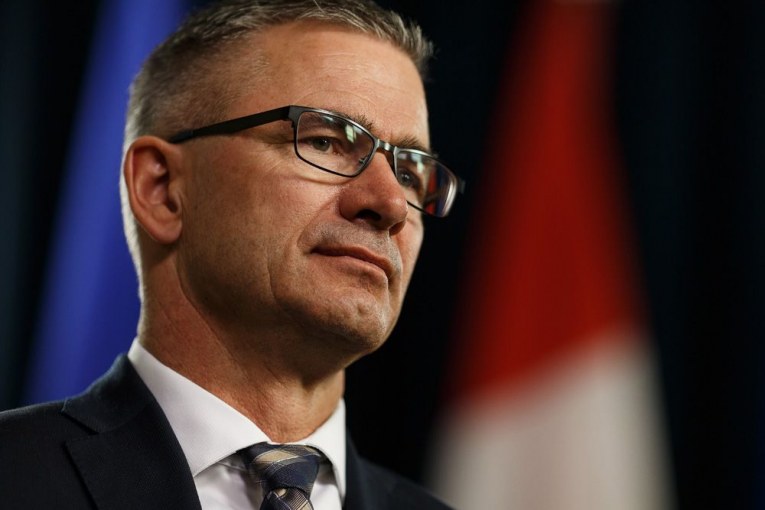
The province’s deficit this year is now forecast to reach $21.3 billion, $2.8 billion lower than forecast in August, when Alberta Premier Jason Kenney’s United Conservative government last provided a budget update.
The lower projected deficit would still make it the largest on record in the province.
“We are beginning to see early signs of a recovery,” Toews said but warned the province faces a “great economic challenge.”
“Earlier this year, Alberta was hit by a triple black swan event,” Alberta Finance Minister Travis Toews said Tuesday, referring to the COVID-19 pandemic, the resulting global drop in oil prices, and a worldwide recession amid lockdowns. “These three things have combined to hit Alberta and our resource-based economy much harder than other jurisdictions.”
Tuesday’s updated budget showed the province, home to Canada’s biggest oil producers, lost 360,900 jobs between February and April this year. While the province has since recovered 258,000 of those jobs, more than 102,000 people remain out of work compared with the start of the year.
The province now forecasts its unemployment rate will average 11.6 per cent this year and won’t return to pre-pandemic levels until 2023, when the jobless rate will climb back up to 6.8 per cent.
Alberta had been resisting stricter measures to contain the second wave of coronavirus infections over concerns about the economy and further job losses, even as other provinces such as Ontario and Manitoba have restricted economic activity to rein in rising coronavirus cases.
In June, Fitch Ratings downgraded Alberta’s credit to AA- from AA and revised its outlook to negative as a result of “sharply higher provincial borrowing during the pandemic-driven economic crisis.”
Similarly, in July, Moody’s Investors Service predicted that Alberta’s government revenues would be more challenged by the pandemic than any other province in Canada.
After four days of record-setting cases, including 1,549 newly identified cases on Monday, provincial cabinet ministers met to discuss new rules to limit the spread while trying to avoid a double-dip recession.
In the hours before the new COVID-19 restrictions were introduced Tuesday, Alberta’s fiscal update forecasted a real gross domestic product (GDP) contraction of 8.1 per cent in 2020.
That’s worse than the 7.3 per cent contraction forecast by The Canadian Imperial Bank of Commerce in a new report on Tuesday before the Alberta budget was released.
“The two largest oil-producing provinces of Alberta and Newfoundland & Labrador have the longest road to recovery due to the negative effect of both the pandemic and weak oil prices on their economies,” CIBC said in its 2021 outlook.
At the same time, energy sector investment in the province is expected to plunge 30 per cent this year.
As oil prices crashed this spring, producers in the province shut in 800,000 barrels per day of oil production and as a result the province expects total oil production this year to average 3.3 million bpd, or 250,000 bpd fewer than in 2019.
The crash has caused Alberta to revise its expectations for oil prices over the next three years, lowering its budget estimates considerably.
The province now expects the West Texas Intermediate oil price benchmark to average US$45 per barrel for the 2021/2022 fiscal year, compared with previous assumptions of US$55 per barrel, and US$54.90 per barrel in 2022/2023, down from an expected US$62.90 per barrel.
As a result, Alberta’s non-renewable resource revenues, including money from oil and gas royalties and land sales, are expected to plunge 72 per cent to just under $1.7 billion this year, compared with $5.9 billion last year.
The province has also abandoned plans to balance its budget within the next three years as a result of the massive declines in investment and oil and gas revenues.
“Flexibility dictates that government cannot adhere to the plan to balance the budget in 2022-2023,” the province’s mid-year fiscal update states, which also notes that Alberta is facing its biggest economic shock since the 1930s.
In place of a balanced budget, the province is adopting fiscal anchors, which include reducing per-capita public spending to a comparable level with other provinces and a pledge to keep net debt to gross domestic product (GDP) below 30 per cent.
Once the pandemic ends, the province expects to develop a new plan and timeline to balance the budget, but Toews declined to say when it hoped to achieve a balanced budget.
He said it would be “disingenuous” to provide a date for those targets now.
“Reluctantly but necessarily we will have to delay balancing the budget,” Toews told reporters Tuesday.
“Right now, with our great economic challenge and a significant reduction in revenues that will be with us for some years, we will not be able to balance in our first term.”
A major part of the new deficit figure is better-than-expected government revenues, which are now forecast to be $41.4 billion, or roughly $3 billion higher than the government previously expected.
Still, the twin threats of the oil price crash and the coronavirus pandemic have forced the province to revise downward its expected revenues for the next three years.
“Corporate earnings will be much lower this year and next year because of the economic challenge,” Toews said.
The province expects that non-renewable resource revenues and corporate tax revenues will not recover to pre-pandemic levels until 2023.
• Email:
You can read more of the news on source
